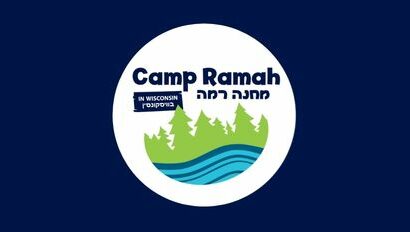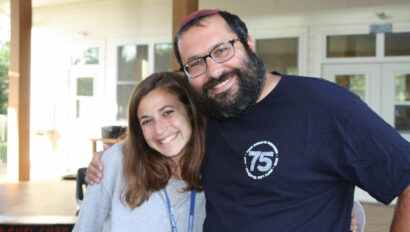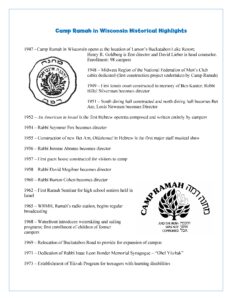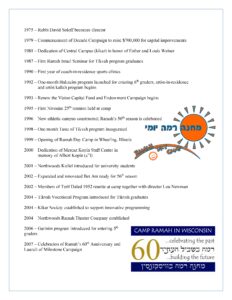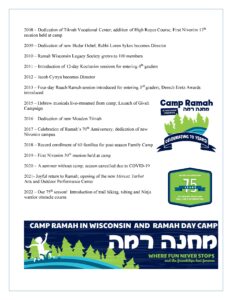
At camp you may have seen Ron Schrag throwing a frisbee on the kikar, shooting hoops on the basketball court, teaching campers in the art room, or in the tzrif (cabin) as a madrich (counselor). But did you know that he also teaches Hebrew at the college level, while he is a student? I was talking with Ron earlier this year about camp and school and he shared this impressive story about how he became a Hebrew teacher. We are privileged to have staff members who change the world in so many ways – through creative writing, by working with people who are incarcerated, and who are changing the world by learning more about co-existence. Now here is a person changing the world by teaching Hebrew to mostly non-Jewish students on a college campus, introducing them to Jewish language, culture and belief. In his most recent class, Ron told me he "taught the students all the vocabulary words on the recipes and then we spent the next class cooking and eating. We made shakshuka, matbucha, hummus, tchina, falafel, and bourekas. Everyone loved it!" Kol HaKavod, Ron–thanks for sharing the story and for being a דוגמה אישית! –Rabbi Loren Sykes
Last year, an Austrian student here at Knox College in Galesburg, Illinois, asked me to teach him Hebrew. He was interested in Israeli culture and had spent the previous summer in Israel, interning for Konrad Adenauer Stiftung, also known as the Konrad Adenauer Foundation. (Unrelated but interesting–one of the Austrian student's relatives was sent to Auschwitz during the Shoah as punishment for hiding Jews.) So last term, we made the arrangements for an independent study in Modern Hebrew. Independent studies are very common here at Knox; most students do some sort of independent study during their time here. However, it's not the norm for students to teach classes. After some discussion, the registrar and the dean of the college approved this idea and gave me permission to teach Hebrew to Knox students, for credit. I found a Jewish professor who speaks some Hebrew–Professor Penny Gold–to be my advisor. We meet weekly and she gives me advice on the pedagogical aspect of the class. She is also the instructor of record, meaning she formally assigns the grades (my grades and the students' grades). For my work, I am receiving one credit (each class here is worth one credit), and my students are receiving half a credit.
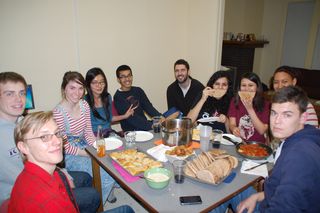 At the beginning of this term, my Hebrew class had four students. The first class went well; word spread, and nine students showed up for the second class. After that, two more joined. So now I am teaching Hebrew to 11 students, only one of whom is Jewish. Registration has since closed, but many others have asked to join the class. We meet three times a week, for an hour each time. I am working with a textbook–Modern Hebrew for Beginners, by Esther Raizen. Homework is assigned and there are weekly assessments as well. So far, we have learned the alef-bet, the vowels, and a good amount of vocabulary. We are currently studying sentence structure, conjugation, and practicing our reading skills. Hopefully before the term ends, my students will be able to read a children's book, learn to count, and be exposed to some Israeli music.
At the beginning of this term, my Hebrew class had four students. The first class went well; word spread, and nine students showed up for the second class. After that, two more joined. So now I am teaching Hebrew to 11 students, only one of whom is Jewish. Registration has since closed, but many others have asked to join the class. We meet three times a week, for an hour each time. I am working with a textbook–Modern Hebrew for Beginners, by Esther Raizen. Homework is assigned and there are weekly assessments as well. So far, we have learned the alef-bet, the vowels, and a good amount of vocabulary. We are currently studying sentence structure, conjugation, and practicing our reading skills. Hopefully before the term ends, my students will be able to read a children's book, learn to count, and be exposed to some Israeli music.
This has been a great experience for me so far. I enjoy teaching others my native language, and am excited by the fact that others want to learn it! I am glad this worked out so well; I get to share my knowledge with others and simultaneously, I am able to practice my teaching skills. As an education major, this is an invaluable experience for me–I am learning a lot about lesson planning and classroom management.
 At the beginning of this term, my Hebrew class had four students. The first class went well; word spread, and nine students showed up for the second class. After that, two more joined. So now I am teaching Hebrew to 11 students, only one of whom is Jewish. Registration has since closed, but many others have asked to join the class. We meet three times a week, for an hour each time. I am working with a textbook–Modern Hebrew for Beginners, by Esther Raizen. Homework is assigned and there are weekly assessments as well. So far, we have learned the alef-bet, the vowels, and a good amount of vocabulary. We are currently studying sentence structure, conjugation, and practicing our reading skills. Hopefully before the term ends, my students will be able to read a children's book, learn to count, and be exposed to some Israeli music.
At the beginning of this term, my Hebrew class had four students. The first class went well; word spread, and nine students showed up for the second class. After that, two more joined. So now I am teaching Hebrew to 11 students, only one of whom is Jewish. Registration has since closed, but many others have asked to join the class. We meet three times a week, for an hour each time. I am working with a textbook–Modern Hebrew for Beginners, by Esther Raizen. Homework is assigned and there are weekly assessments as well. So far, we have learned the alef-bet, the vowels, and a good amount of vocabulary. We are currently studying sentence structure, conjugation, and practicing our reading skills. Hopefully before the term ends, my students will be able to read a children's book, learn to count, and be exposed to some Israeli music. This has been a great experience for me so far. I enjoy teaching others my native language, and am excited by the fact that others want to learn it! I am glad this worked out so well; I get to share my knowledge with others and simultaneously, I am able to practice my teaching skills. As an education major, this is an invaluable experience for me–I am learning a lot about lesson planning and classroom management.
